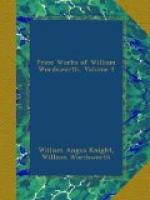335. Water-fowl. [Sonnet III. l. 1.]
‘Screams round the Arch-druid’s brow the sea-mew.’
This water-fowl was among the Druids an emblem of those traditions connected with the deluge that made an important part of their mysteries. The cormorant was a bird of bad omen.
336. Hill at St. Allan’s: Bede.
‘That hill, whose flowery platform,’ &c. [Sonnet VI. l. 13.]
This hill at St. Alban’s must have been an object of great interest to the imagination of the venerable Bede, who thus describes it, with a delicate feeling delightful to meet with in that rude age, traces of which are frequent in his works:—’Variis herbarum floribus depictus imo usquequaque vestitus, in quo nihil repente arduum, nihil praeceps, nihil abruptum, quem lateribus longe lateque deductum in modum aequoris natura complanat, dignum videlicet eum pro insita sibi specie venustatis jam olim reddens, qui beati martyris canore dicaretur.’
337. Hallelujahs.
‘Nor wants the
cause the panic-striking aid Of hallelujahs.’
[Sonnet XI. ll. 1-2.]
Alluding to the victory gained under Germanus. See Bede.
338. Samuel Daniel and Thomas Fuller . [Ibid. ll. 9-10.]
’By men yet scarcely
conscious of a care
For other monuments than those
of earth.’
The last six lines of this Sonnet are chiefly from the prose of Daniel; and here I will state (though to the Readers whom this Poem will chiefly interest it is unnecessary) that my obligations to other prose writers are frequent,—obligations which, even if I had not a pleasure in courting, it would have been presumptuous to shun, in treating an historical subject. I must, however, particularise Fuller, to whom I am indebted in the Sonnet upon Wycliffe and in other instances. And upon the acquittal of the Seven Bishops I have done little more than versify a lively description of that event in the MS. Memoirs of the first Lord Lonsdale.
339. Monastery of Old Bangor. [Sonnet XII.]
After a quotation from Turner’s ‘valuable History of the Anglo-Saxons.’ Taliesen was present at the battle which preceded this desolation. The account Bede gives of this remarkable event, suggests a most striking warning against National and Religious prejudices.
340. Paulinus. [Sonnet XV.]
The person of Paulinus is thus described by Bede, from the memory of an eye-witness: ’Longae staturae, paululum incurvus, nigro capillo, facie macilenta, naso adunco, pertenui, venerabilis simul et terribilis aspectu.’
341. King Edwin and the Sparrow.
‘Man’s life is like a sparrow.’ [Sonnet XVI. l. 1.]




